
Comesperma is a genus of shrubs, herbs and lianas in the family Polygalaceae. The genus is endemic to Australia. It was defined by the French botanist Jacques Labillardière in his 1806 work Novae Hollandiae Plantarum Specimen. The genus name is derived from the Ancient Greek words come ("hair") and sperma ("seed"), and relates to the seeds bearing tufts of hair. The genus is distributed over southern Australia, particularly in the southwest of Western Australia, where 19 species are found. 24 species have been described.
Chthonocephalus is a genus of annual herbs in the family Asteraceae. The genus is endemic to Australia, with species occurring in all mainland states.
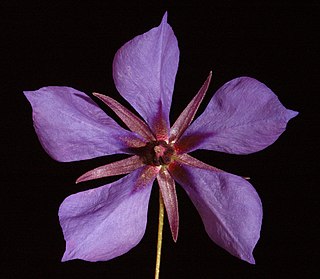
Platytheca is a genus of small shrubs in the family Elaeocarpaceae from the south-west of Western Australia. The genus was formally described by Joachim Steetz, his description published in Plantae Preissianae in 1845.
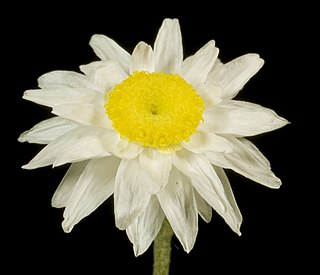
Hyalosperma is a genus of Australian flowering plants in the family Asteraceae.

Siloxerus is a genus of Australian plants in the tribe Gnaphalieae within the family Asteraceae.

Pogonolepis is a genus of Australian plants in the tribe Gnaphalieae within the family Asteraceae.

Ozothamnus lepidophyllus is a shrub in the family Asteraceae, native to Western Australia. It is erect, growing from 0.25 to 0.6 m high with white flowers and grows on loamy, sandy and rocky soils.

Waitzia acuminata, commonly known as orange immortelle, is an annual forb in the family Asteraceae. It is native to Australia. Plants grow to between 10 and 60 cm in height and have leaves that are long and narrow. These are between 2 and 7 cm long and 2 to 5 mm in width. The yellow, orange or white flowers appear between July and January. Waitzia Acuminata occurs in all mainland states of Australia and is currently not considered rare or endangered. Its genus Waitzia is named after German botanist Karl Friedrich Waitz. Acuminata is a latin name describing things that are tapered to a point, named after the plants spindle like outer bracts.
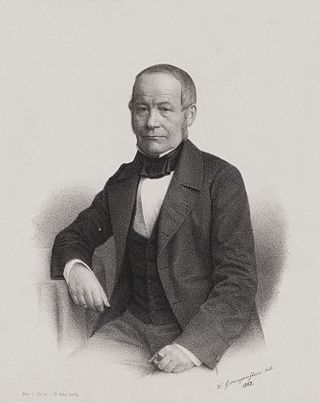
Joachim Steetz was a German botanist. His herbarium, comprising more than 5000 specimens from over 160 collectors and 30 countries was purchased in 1863 by Victorian Government Botanist Ferdinand von Mueller for the sum of 80 pounds. The collection is currently housed at the National Herbarium of Victoria. The herbarium was compiled by Steetz over more than thirty years and comprises 160 collectors from more than 30 countries, including type specimens from plant collectors of the time including:
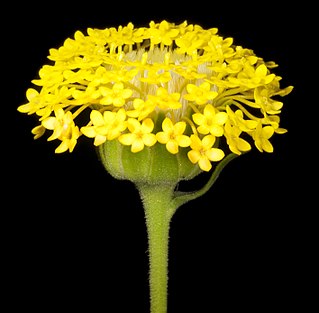
Podotheca chrysantha is a small herb in the family Asteraceae endemic to Western Australia. It grows from 0.2 to 0.5 m high, and has yellow flowers which are seen from August to December. It grows in sand over limestone or laterite on limestone ridges and in wet depressions.

Tetratheca hispidissima is an erect spreading or straggling shrub in the family Elaeocarpaceae. It is endemic to Western Australia. It grows from 0.3 m to 0.8 m high, on sandy, clayey and gravel soils on river flats and on lateritic ridges. Its pink to purple flowers may be seen from September to December.
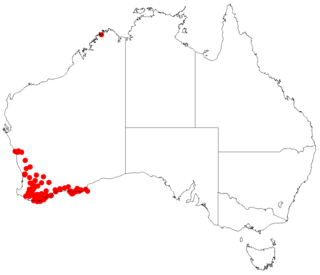
Asteridea nivea is a herb in the Asteraceae family, which is endemic to Western Australia. It was first described in 1845 by Joachim Steetz as Chrysodiscus niveus. In 1980, G. Kroner assigned it to the genus, Asteridea, giving it the name Asteridea nivea. It is a perennial herb, sometimes erect, sometimes low-spreading which grows on sandy soils often over granite, laterite, or limestone to heights from 10 cm to 60 cm, in rock crevices, on ridges and coastal cliffs. Its white to white-pink flowers may seen from April to May or August to September in Beard's South-West Province, that is, the IBRA regions of Avon Wheatbelt, Esperance Plains, Geraldton Sandplains, Jarrah Forest, Mallee, and Warren.

Argentipallium niveum is a species of flowering plant within the genus, Argentipallium, in the daisy family (Asteraceae). It is endemic to Western Australia.

Comesperma drummondii, commonly known as Drummond's milkwort, is a slender herb in the family Polygalaceae. It is a perennial herb growing to between 20 cm and 1.2 m high, on sandy and gravelly soils Its pink-blue-purple flowers may be seen from August to November.

Pterochaeta is a monotypic plant genus in the Asteraceae family, endemic to Western Australia. It was first described in 1845 by Joachim Steetz and its only species is Pterochaeta paniculata.
Olearia lehmanniana is a species of flowering plant in the family Asteraceae and is endemic to inland areas of the south-west of Western Australia. It is a shrub with scattered elliptic or linear leaves that are densely hairy on the lower surface, and pale mauve, daisy-like inflorescences.

Olearia muricata, commonly known as rough-leaved daisy bush, is a species of flowering plant in the family Asteraceae and is endemic to the south-west of Western Australia. It is an erect shrub with flat, linear to triangular leaves, and white or pale mauve and yellow, daisy-like inflorescences.
Olearia strigosa, commonly known as bristly daisy bush, is a species of flowering plant in the family Asteraceae and is endemic to the south-west of Western Australia. It is an erect shrub with linear leaves and blue or purple, daisy-like inflorescences.

Schoenia cassiniana is a species of plant in the tribe Gnaphalieae within the family Asteraceae, native to Western Australia, South Australia and the Northern Territory. It was first described in 1829 by Charles Gaudichaud-Beaupré as Helichrysum cassinianum, but was transferred to the genus Schoenia in 1845 by Joachim Steetz.

Brachyscome bellidioides is a species of flowering plant in the family Asteraceae and is endemic to the southwest of Western Australia. It is an annual herb with linear leaves and yellow and white daisy-like flowers.

















